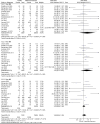Efficacy of thoracic endovascular aortic repair versus medical therapy for treatment of type B aortic dissection
- PMID: 39261808
- PMCID: PMC11391845
- DOI: 10.1186/s12893-024-02555-4
Efficacy of thoracic endovascular aortic repair versus medical therapy for treatment of type B aortic dissection
Abstract
Background: Techniques in endovascular therapy have evolved to offer a promising alternative to medical therapy alone for Type B aortic dissections (TBADs).
Aim: The aim of this meta-analysis was to compare mortality and overall complications between thoracic endovascular aortic repair (TEVAR) and best medical therapy (BMT) in patients with TBADs.
Methods: We included randomized control trials and prospective or retrospective cohort studies that compared TEVAR and BMT for the treatment of type B aortic dissection. Multiple electronic databases were searched.
Results: Thirty-two cohort studies including 150,836 patients were included. TEVAR was associated with a significantly lower 30-day mortality rate than BMT (RR = 0.79, CI = 0.63, 0.99, P = 0.04), notably in patients ≥ 65 years of age (RR = 0.78, CI = 0.64, 0.95, P = 0.01). The TEVAR group had a significantly prolonged hospital stay (MD = 3.42, CI = 1.69, 5.13, P = 0.0001) and ICU stay (MD = 3.18, CI = 1.48, 4.89, P = 0.0003) compared to the BMT. BMT was associated with increased stroke risk (RR = 1.52, CI = 1.29, 1.79, P < 0.00001). No statistically significant differences in late mortality (1, 3, and 5 years) or intervention-related factors (acute renal failure, spinal cord ischemia, myocardial infarction, respiratory failure, and sepsis) were noted between the groups.
Conclusion: Our meta-analysis revealed a significant association between the TEVAR group and a decreased mortality rate of TBAD compared to the medical treatment group, especially in patients aged 65 years or older. Further randomized controlled trials are needed to confirm our findings.
Keywords: Medical therapy; Thoracic endovascular aortic repair; Type B aortic dissection.
© 2024. The Author(s).
Conflict of interest statement
The authors declare no competing interests.
Figures
















Similar articles
-
Comparison of thoracic endovascular aortic repair, open surgery and best medical treatment for type B aortic dissection: A meta-analysis.Int J Cardiol. 2018 Jan 1;250:240-246. doi: 10.1016/j.ijcard.2017.10.050. Epub 2017 Oct 16. Int J Cardiol. 2018. PMID: 29066151 Review.
-
Comparison of the efficacy and safety of thoracic endovascular aortic repair with open surgical repair and optimal medical therapy for acute type B aortic dissection: A systematic review and meta-analysis.Int J Surg. 2020 Nov;83:53-61. doi: 10.1016/j.ijsu.2020.08.051. Epub 2020 Sep 11. Int J Surg. 2020. PMID: 32927144
-
Nationwide comparative impact of thoracic endovascular aortic repair of acute uncomplicated type B aortic dissections.Vasc Endovascular Surg. 2014 Apr;48(3):230-3. doi: 10.1177/1538574413518122. Epub 2014 Jan 6. Vasc Endovascular Surg. 2014. PMID: 24399132
-
Early and midterm outcomes of in situ laser fenestration during thoracic endovascular aortic repair for acute and subacute aortic arch diseases and analysis of its complications.J Vasc Surg. 2020 Nov;72(5):1524-1533. doi: 10.1016/j.jvs.2020.01.072. Epub 2020 Apr 6. J Vasc Surg. 2020. PMID: 32273224
-
Comparison of mid-term outcomes of endovascular repair and medical management in patients with acute uncomplicated type B aortic dissection.J Thorac Cardiovasc Surg. 2021 Jul;162(1):26-36.e1. doi: 10.1016/j.jtcvs.2019.11.127. Epub 2019 Dec 24. J Thorac Cardiovasc Surg. 2021. PMID: 31982125
Cited by
-
Causal relationship between serum metalloproteinase 12 levels and aortic dissection and aortic aneurysm: a bidirectional Mendelian randomization study.J Thorac Dis. 2025 Apr 30;17(4):2377-2385. doi: 10.21037/jtd-2025-377. Epub 2025 Apr 27. J Thorac Dis. 2025. PMID: 40400971 Free PMC article.
References
-
- de Grubb MCM, Kilbourne B, Kilbourne K, Langston M, Gittner L, Zoorob RJ, et al. Socioeconomic, environmental, and geographic factors and US lung cancer mortality, 1999‐2009. Family Medicine and Community Health. 2017;5(1):3–12.
Publication types
MeSH terms
LinkOut - more resources
Full Text Sources

